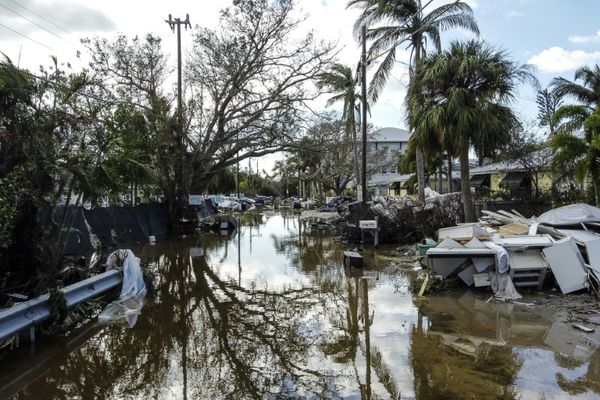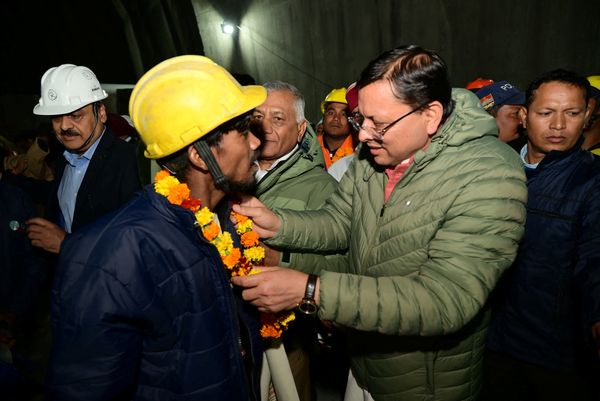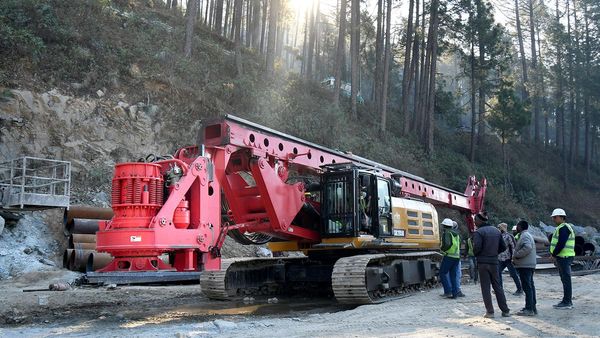Despite multiple setbacks, officials were hopeful of a breakthrough in their operation to rescue the 41 workers trapped in Silkyara tunnel in Uttarkashi, as manual horizontal drilling commenced on Monday. Madras Sappers, an engineering group of the Corps of Engineers of the Indian Army, are overseeing the digging operation which employs “rat mining” technique to remove debris. Civilians experienced in rat-hole mining are assisting the Sappers in the process.
Simultaneously, vertical drilling too was carried out, and reached a depth of 36 metres till 7 p.m. Vertically, rescuers need to drill through 86 metres of mountain while manual horizontal drilling must be undertaken for a further 10-12 metres. They covered 0.9 metres on Monday.
Also read: Uttarkashi tunnel collapse Live Updates on November 27, 2023
On the 16th day of operations, Uttarakhand Government Secretary Neeraj Khairwal told presspersons in the evening that after over three days, all the parts of the “broken” U.S.-made Auger machine were removed from the drilling area and manual drilling had commenced.
“After we removed the Auger, it was found that the machine had also damaged 1.9 meters of pipe. We managed to cut that out as well. By working manually, which started in the evening, the rat miners managed to cover 0.9 metres which is obviously the part where the broken Auger was stuck,” said Mr. Khairwal, who added that he hoped that the workers would get evacuated soon through horizontal drilling.
Speaking about rat mining, a senior official in State Disaster Response Force (SDRF) said it is a method generally used in Meghalaya to extract coal from narrow pits dug into the ground. The rat miners generally make holes only large enough for one person to enter.
“Most of the rat miners are low-wage labourers. Inside these small pits, primitive tools such as shovels and baskets are used to extract coal. It is not a very safe and scientific practice but we hope that this will work for us at this tunnel site,” he added.
Parsadi Lodhi who lives in Delhi and has been deployed at the Silkyara rescue site, said he has been “doing rat drilling for years and is happy to be a part of the rescue operations”. “They are also labourers like us. I wish if we manage to get them out,” said Mr. Lodhi.
Speaking about vertical drilling, where the target to bore through the entire 86 metres in 100 hours, Mahmood Ahmed, Additional Secretary, Ministry of Road Transport and Highways, said the work is under way at a fast pace but utmost caution is being taken considering the geology of the rescue site.
The authorities heading the operations are also concerned for the safety of the rescue teams as reportedly, geological experts have warned of muck and debris falling on them. To save the rescuers working round the clock, the process of erecting “false ribs” - support structures - on the top of tunnel started on November 25. In the last 48 hours, eight such structures, towards the tunnel’s exit on Silkyara side, have been erected.
Milind Raj, a robotic scientist, who also joined the rescue operations on Monday, claimed that he has built a robot which will be sent inside the tunnel, via the six-inch lifeline pipe, and not only monitor the health of the workers but will also help in detecting hazardous gases inside, like methane.
“I have placed all the systems. This robot, built with indigenous technology in just 40 hours, is for ‘SoS’ operations and will be immediately activated as and when required,” Mr. Raj told The Hindu.
The robotics expert claimed that he has extended his services voluntarily and his robot perform three tasks simultaneously - providing Internet services; monitoring mental health parameters of workers, such as stress, within 100 metres; and detecting hazardous gases inside the tunnel.
P.K. Mishra, Principal Secretary to Prime Minister Narendra Modi and Ajay Bhalla, Secretary, Ministry of Home Affairs, also reached Silkyara to take the stock of the situation. The officials were briefed about the geological conditions and rescue operations by the authorities concerned along with challenges being faced by the rescue teams.
Mr. Mishra spoke to the trapped workers via the communication channel set up by the Uttarakhand SDRF and inquired about their health and mental well-being. He also had a chat with the rescue teams and motivated them to work consistently for the rescue of trapped workers.
For the uninitiated, on November 12, a portion of the under-construction Silkyara-Barkot tunnel in Uttarakhand collapsed, trapping 41 labourers behind 60 metres of debris. The area of entrapment, measuring 8.5 meters in height and two kilometres in length, is the built-up portion of the tunnel, offering safety to the labours with electricity and water supply available. Food is being provided to the men as rescuers had managed to push a six-inch diameter pipe through the debris inside the tunnel.
Initially, authorities opted to insert a 900-mm pipe through the debris, but safety concerns led to the exploration of multiple rescue options simultaneously.










